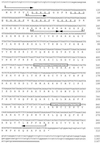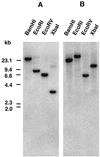Molecular cloning and targeting of a fibrillarin homolog from Arabidopsis
- PMID: 10806224
- PMCID: PMC58981
- DOI: 10.1104/pp.123.1.51
Molecular cloning and targeting of a fibrillarin homolog from Arabidopsis
Abstract
Fibrillarin is a nucleolar protein known to be involved in the processing of ribosomal RNA precursors. We isolated AtFbr1, a cDNA encoding a homolog of fibrillarin in Arabidopsis. The cDNA is 1.2 kb in size and encodes a polypeptide of 310 amino acid residues with a molecular mass of 33 kD. AtFbr1 is expressed at high levels in the flower and root tissue and at a slightly lower level in leaf tissue, whereas it was nearly undetectable in siliques. Expression of AtFbr1 was compared with that of the FLP (fibrillarin-like protein) gene identified by the Arabidopsis genome project. Abscisic acid treatment resulted in the down-regulation of the expression of both AtFbr1 and FLP genes in seedlings, although the degree of suppression was higher for FLP than for AtFbr1. In addition, the expression level of FLP decreased with the age of the seedlings, whereas AtFbr1 did not exhibit any detectable change. The subcellular localization of AtFbrl was studied with an in vivo targeting approach using a fusion protein, and was found to be correctly targeted to the nucleolus in protoplasts when expressed as a green fluorescent fusion protein (GFP). Deletion experiments showed that the N-terminal glycine- and arginine-rich region is necessary and sufficient to target AtFbr1 to the nucleolus.
Figures







Similar articles
-
Molecular cloning and gene expression of a fibrillarin homolog of tobacco BY-2 cells.Protoplasma. 2006 Nov;229(1):53-62. doi: 10.1007/s00709-006-0183-1. Epub 2006 Oct 6. Protoplasma. 2006. PMID: 17019528
-
Molecular cloning of an Arabidopsis cDNA encoding a dynamin-like protein that is localized to plastids.Plant Mol Biol. 1998 Oct;38(3):437-47. doi: 10.1023/a:1006099718761. Plant Mol Biol. 1998. PMID: 9747851
-
Molecular cloning and sequence analysis of U3 snoRNA-associated mouse fibrillarin.Biochim Biophys Acta. 1993 Oct 19;1216(1):119-22. doi: 10.1016/0167-4781(93)90046-g. Biochim Biophys Acta. 1993. PMID: 8218401
-
An unusual fibrillarin gene and protein: structure and functional implications.Mol Biol Cell. 1997 Jun;8(6):1051-61. doi: 10.1091/mbc.8.6.1051. Mol Biol Cell. 1997. PMID: 9201715 Free PMC article.
-
Characterization and expression of two cDNAs encoding carbonic anhydrase in Arabidopsis thaliana.Plant Physiol. 1994 Jun;105(2):707-13. doi: 10.1104/pp.105.2.707. Plant Physiol. 1994. PMID: 7520589 Free PMC article.
Cited by
-
Identification of a signal that distinguishes between the chloroplast outer envelope membrane and the endomembrane system in vivo.Plant Cell. 2001 Oct;13(10):2175-90. doi: 10.1105/tpc.010232. Plant Cell. 2001. PMID: 11595795 Free PMC article.
-
The pentratricopeptide repeat protein DELAYED GREENING1 is involved in the regulation of early chloroplast development and chloroplast gene expression in Arabidopsis.Plant Physiol. 2008 Jun;147(2):573-84. doi: 10.1104/pp.108.116194. Epub 2008 Apr 9. Plant Physiol. 2008. PMID: 18400937 Free PMC article.
-
Plant ribosomes as a score to fathom the melody of 2'-O-methylation across evolution.RNA Biol. 2024 Jan;21(1):70-81. doi: 10.1080/15476286.2024.2417152. Epub 2024 Nov 7. RNA Biol. 2024. PMID: 39508203 Free PMC article. Review.
-
Characterization of karyopherin cargoes reveals unique mechanisms of Kap121p-mediated nuclear import.Mol Cell Biol. 2004 Oct;24(19):8487-503. doi: 10.1128/MCB.24.19.8487-8503.2004. Mol Cell Biol. 2004. PMID: 15367670 Free PMC article.
-
Deciphering the epitranscriptome: A green perspective.J Integr Plant Biol. 2016 Oct;58(10):822-835. doi: 10.1111/jipb.12483. Epub 2016 Jun 20. J Integr Plant Biol. 2016. PMID: 27172004 Free PMC article. Review.
References
-
- Abel S, Theologis A. Transient transformation of Arabidopsis leaf protoplasts: a versatile experimental system to study gene expression. Plant J. 1994;5:421–427. - PubMed
-
- Altschul SF, Gish W, Miller W, Myers EW, Lipman DJ. Basic local alignment search tool. J Mol Biol. 1990;215:403–410. - PubMed
-
- Ausubel FM, Brent R, Kingston RE, Moore DD, Seidman JG, Smith JA, Struhl K. Current Protocols in Molecular Biology. New York: Greene Publishing Associates/Wiley- Interscience; 1989.
Publication types
MeSH terms
Substances
LinkOut - more resources
Full Text Sources
Other Literature Sources
Molecular Biology Databases

